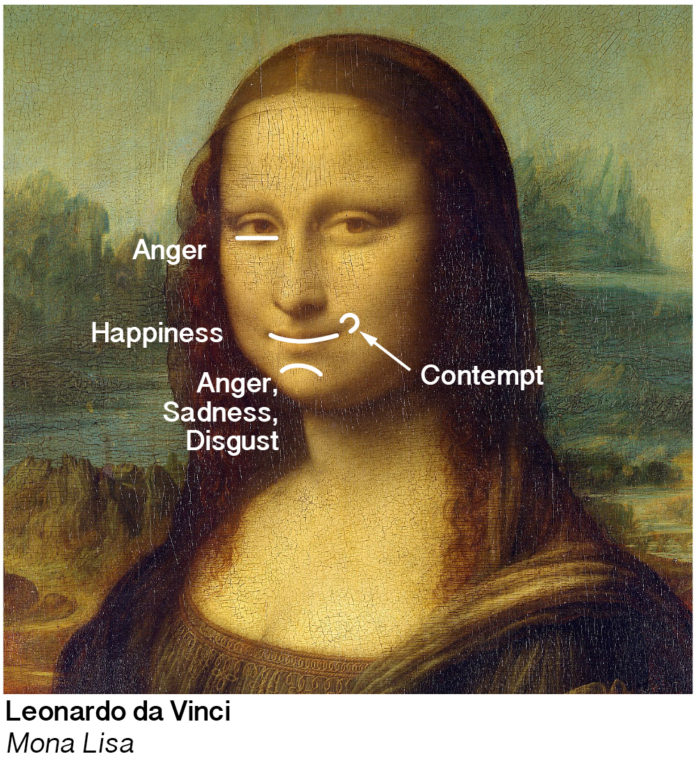On the mystery of the Mona Lisa > An essay by Dr. Dan Hill, author of “First Blush: People’s Intuitive Reactions to Famous Art.”
BY DR. DAN HILL
Author of “First Blush: People’s Intuitive Reactions to Famous Art”
Acclaim for Leonardo da Vinci’s Mona Lisa qualifies as a good place to start in discussing why faces matter in art. That’s true not only because of da Vinci’s celebrated genius, but also because anyone who considers the portrait to be magical mostly because of Mona Lisa’s faint “smile” is missing the point. There are several different emotions evident on Mona Lisa’s face – with happiness being merely one of them.
Look closely and in viewing the painting you’ll see a smirk at play on the right side of the woman’s face. Why might Mona Lisa be showing a sign of contempt? Could it be that as the wife of a successful Florentine merchant, she’s betraying her sense of herself as superior to da Vinci (a painter of illegitimate birth)? Or in turn, what about the woman’s taut left, lower eyebrow – a sure sign of anger. Where does that feeling come from? And the same question pertains to the raised chin that signals a mixture of anger, disgust and sadness. What’s the possible story behind those emotions?
Could it be that Mona Lisa simply felt this way often, characteristically, and da Vinci picked up on that tendency? Or is it possible that Mona Lisa had grown weary (sadness) and annoyed (angry) and finally even put off (disgust) by da Vinci’s perfectionism? After all, even before the painter carried the painting on the back of a mule to Paris, where he kept refining it until his death, da Vinci had already put in four years of work on this portrait – as long as Michelangelo took to paint the entire ceiling that crowns the Sistine Chapel.
Surely, part of the popularity and downright fascination we have with Mona Lisa is the portrait’s emotional richness. To describe Mona Lisa as having a world-weary smile is merely an appetizer in what’s actually a five-course meal.
How did da Vinci achieve this feat? It wasn’t by chance. Like his fellow artist and near-contemporary, Michelangelo, da Vinci took advantage of dissection to learn how human anatomy works. While in Michelangelo’s case, his focus was more on the body and contributed to works like David, in da Vinci’s case his interest had as much to do with the face.
Look at da Vinci’s famous notebooks for confirmation. The guy was the world’s first facial coder – the first person (and artist) to study closely how the face’s muscles move and the emotions those movements convey. Not for another 200 years would anybody rival da Vinci’s ability to discern the signals the face reveals.

Faces will never go away in art for the simple, basic reason that emotions will never go away, either. It’s been said that there are only two currencies in life – dollars and emotions – and portraiture retains its central place because we want to know how people look, and how they feel. Case in point: let’s return to Michelangelo, namely, these eye-tracking results for The Birth of Adam. Why, not even naked skin carries the day here in terms of seizing the bulk of the visual attention. Instead, it’s God’s face that commands more attention.
From my studies I’ve discovered that 70% of the visual attention and 70% of people’s emotional interest or engagement will involve people looking at the face or faces in a painting or photograph when people are present. So it’s a matter of the face, the face, the face. But this is not an ordinary person’s face here. This is God’s face, and as best I know daring to show God’s face is another sign of Michelangelo’s daring talent. Showing the Virgin Mary or Jesus is fairly common in art, after all. As to daring to depict God’s face, however: I can’t think of a single other instance of an artist ever having done so across the history of art!
ABOUT THE AUTHOR
Dan Hill, Ph.D., is the author of “First Blush: People’s Intuitive Reactions to Famous Art,” the largest study ever conducted involving eye tracking and facial coding to capture see/feel responses to art.
Fine Art Today covers artists and products we think you’ll love. Linked products are independently selected and linked to for your convenience. If you buy something using a link on this page, Streamline Publishing may receive a small share of that sale.
> Visit EricRhoads.com to learn about more opportunities for artists and art collectors, including retreats, international art trips, art conventions, and more.
> Sign up to receive Fine Art Today, our free weekly e-newsletter
> Subscribe to Fine Art Connoisseur magazine, so you never miss an issue









The Mona Lisa Smile
A subliminal foreshortened bridge.
The bridge marries two scenic
landscapes on each side of her face drawing focus to her smile.
Darkness, shadow, and light is
transformed into a smile that
Pinnacles laterally across her
face. Thus, creating a visual
bridge that transcends the Mona
Lisa face. A mirage of a near
perfect third dimension. An illusionary idea expressed in paint
through the viewer’s eye imprinting on to the mind as a visual subliminal. Michelangelo divides consciousness and the unconscious with a visual illusion. An intentional deception to master and deceive an overt eye of visual perception as it is perceived by the viewer’s eye. Michelangelo mastered the subliminal mind and the overt eye with paint to fashion the Mona Lisa Smile.
Guillermo B.-Garcia (cc)
I was hoping to stimulate conversation by intentionally saying Michalangelo had painted da Vinci’s Mona Lisa. But at last
no one reads these things.
so a bridge is a bridge and a threshold is a threshold. And there is persons crossing either on this article.